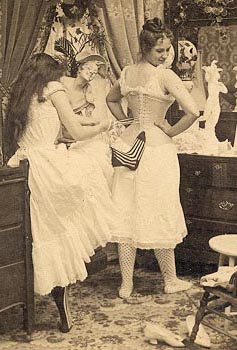 One factor that initially encouraged tight-lacing was that dress denoted the social class and moral worth of the wearer. In The Theory of the Leisure Class (1899), Thorstein Veblen writes that female dress demonstrates ‘the wearer’s abstinence from productive employment.’[1] The extreme bodily modification and the application of force necessary for achieving a tightly-laced corset had debilitating effects upon the wearer, and consequently, a small waist came to be synonymous with the leisured classes. Veblen explains that ‘[t]he corset is, in economic theory, substantially a mutilation, undergone for the purpose of lowering the subject’s vitality and rendering her permanently and obviously unfit for work.’[2] Only a woman who had no need to be economically or domestically productive could afford such a restriction upon her movement and be reduced to a quasi-invalid, suffering from ‘headaches, and other lady-like maladies, that appear the almost exclusive privilege of women in the higher classes’.[3] Yet, when the fashion was adopted by the middle classes, the aristocracy discontinued their tight-lacing in order to distinguish themselves from those of a lower social class. This proved to be an inconvenience, however, one correspondent of Punch (1869) complaining that:
One factor that initially encouraged tight-lacing was that dress denoted the social class and moral worth of the wearer. In The Theory of the Leisure Class (1899), Thorstein Veblen writes that female dress demonstrates ‘the wearer’s abstinence from productive employment.’[1] The extreme bodily modification and the application of force necessary for achieving a tightly-laced corset had debilitating effects upon the wearer, and consequently, a small waist came to be synonymous with the leisured classes. Veblen explains that ‘[t]he corset is, in economic theory, substantially a mutilation, undergone for the purpose of lowering the subject’s vitality and rendering her permanently and obviously unfit for work.’[2] Only a woman who had no need to be economically or domestically productive could afford such a restriction upon her movement and be reduced to a quasi-invalid, suffering from ‘headaches, and other lady-like maladies, that appear the almost exclusive privilege of women in the higher classes’.[3] Yet, when the fashion was adopted by the middle classes, the aristocracy discontinued their tight-lacing in order to distinguish themselves from those of a lower social class. This proved to be an inconvenience, however, one correspondent of Punch (1869) complaining that:
my maid has the impertinence to follow the new fashion, and is getting quite unfit for work through her tight-lacing. When I tell her to run up-stairs to fetch a pocket-hand-kerchief, she moves as slow and stiffly as I do myself, and comes down panting so that she can hardly gasp an answer to my questions. Then she constantly is getting nasty stitches in her side, and while she stands to do my hair she often feels so faint that I have to give her sal volatile.[4]
However, these norms changed throughout the century as a small waist – once the indicator of strict morals and high class – became associated with lower class imitation and was subsequently perceived as a sign of vulgarity.
[1] Thorstein Veblen, The Theory of the Leisure Classes (New York: Dover, 1994), p.105
[2] Veblen, The Theory of the Leisure Classes, p.106
[3] C.E. Tonna, Personal Recollections (London: R.B. Seeley and W. Burnside, 1841), in V. Sanders, Records of Girlhood (Hampshire: Ashgate, 2000), p.71
[4] ‘The Torments of Tight-Lacing’, Punch (1869)

Leave a comment